Home Safety Checklist For Boston
Keeping safe and secure in your residence should be your topmost responsibility. But are you missing some useful safety components? Use this home safety checklist for Boston and see where your home can use some work.
This guide begins with some whole-house safety items, and then we delve down on a room level. Then, you can call (617) 430-5865 or send in the form below for more information.
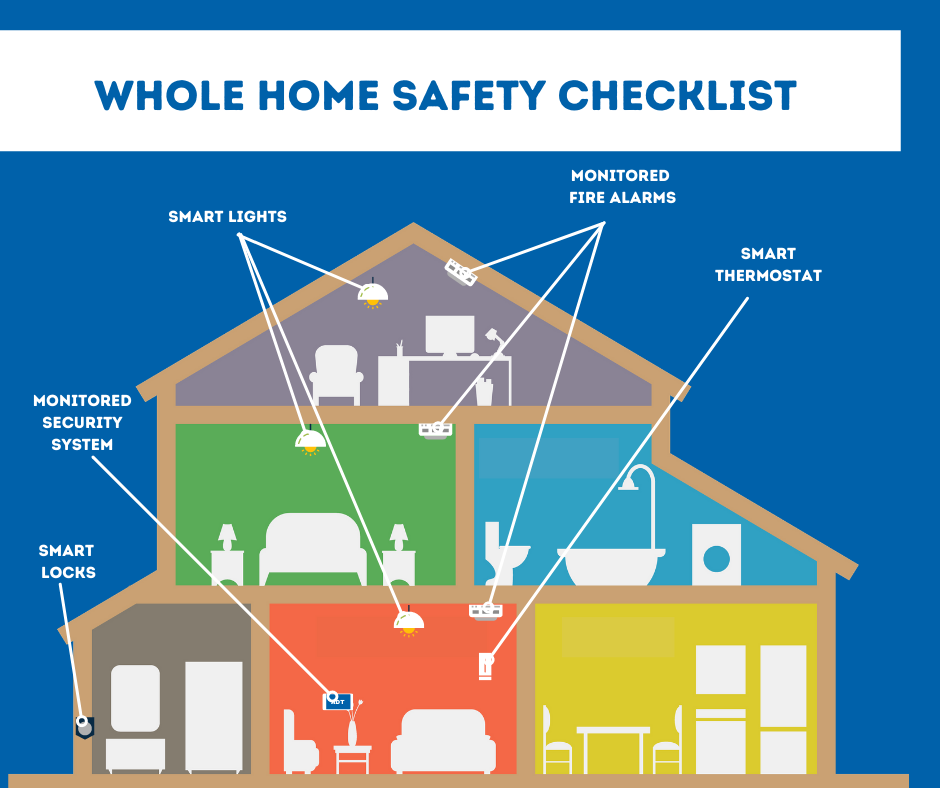
Whole Home Safety Checklist for Boston
While you will want to take a room-by-room method for home safety in Boston, there are some things that work for the whole-house approach. These devices can talk to each other through a wireless hub, and often can respond to other components. You can also manage each of your home safety equipment using a mobile app, such as ADT Control:
-
Monitored Home Security System: All your entryways should employ a sensor that notifies you and your family to forced entry. As the alarm goes off, your monitoring agent picks up the call and immediately calls emergency personnel.
-
Smart Lights For Most Rooms: Of course, you can program your smart bulbs to make your home more efficient. But they can also help you remain safe in an emergency. Have your smart bulbs come on when a sensor triggers to frighten off burglars or light the way out to a safe place.
-
Smart Thermostat: Like your smart lights, a smart thermostat in Boston can save you between 10%-15% in energy spending. But it also can flip on your exhaust fan during a fire.
-
Monitored Fire Detectors: At the very least, you have a fire alarm on every floor. You can improve your fire readiness by utilizing a monitored fire alarm that detects excessive heat and smoke, and alerts your 24/7 monitoring team when it thinks that there’s a fire.
-
Smart Door Locks: Every doorway that needs a deadbolt can use a smart lock. Now you can preset key codes to family and friends and get texts to your phone when the locks are activated. Your doors can even automatically unlock, allowing you to quickly leave if you have a fire or dangerous situation.
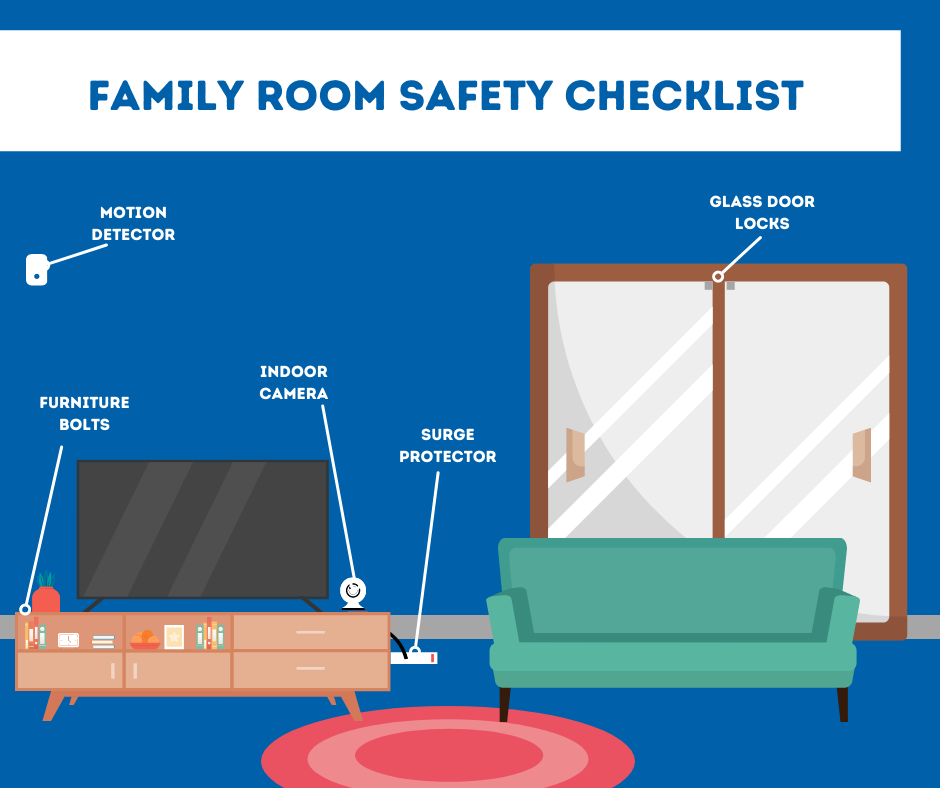
Living Room/Family Room Safety Checklist For Boston
You’ll spend a lot of time in your living room, so it’s the most reasonable room to improve your home safety. Highly sought after items, like a TV or video game console, usually reside in your living room, making it a tempting space for burglars. Start with placing a motion sensor or security camera in there, then try some of these suggestions:
-
Motion Detectors: By putting in motion detectors, you’ll have a loud alarm anytime they sense unusual movement in your family room. The best devices are motion detectors that ignore a dog or cat or you’ll see an alert every time your pet roams by for a bite of food.
-
Indoor Camera: An indoor security camera puts a constant watch on your living room. Watch live feeds of the area so you can find out what’s going on from the mobile app. Or speak with family members in the living room by using the two-way talk feature.
-
Surge Protector/Outlet Maintenance: Make sure you protect all your electronics and stop overtaxing your outlets with a surge protector. For added energy-efficiency, use a smart plug with surge protection included.
-
Furniture Secured To The Wall: If you have babies or toddlers, you’ll want to secure your heavy furniture and entertainment center to your wall. This is especially crucial if your living room uses carpet that can make objects extra unbalanced.
-
Special Locks For Glass Doors: If your family room has a glass door that slides out to a patio, deck, or outside porch, you get that the latch is usually worthless. Put in a custom lock, like a cross bar or locks that bolt to the bottom and top of the frame.
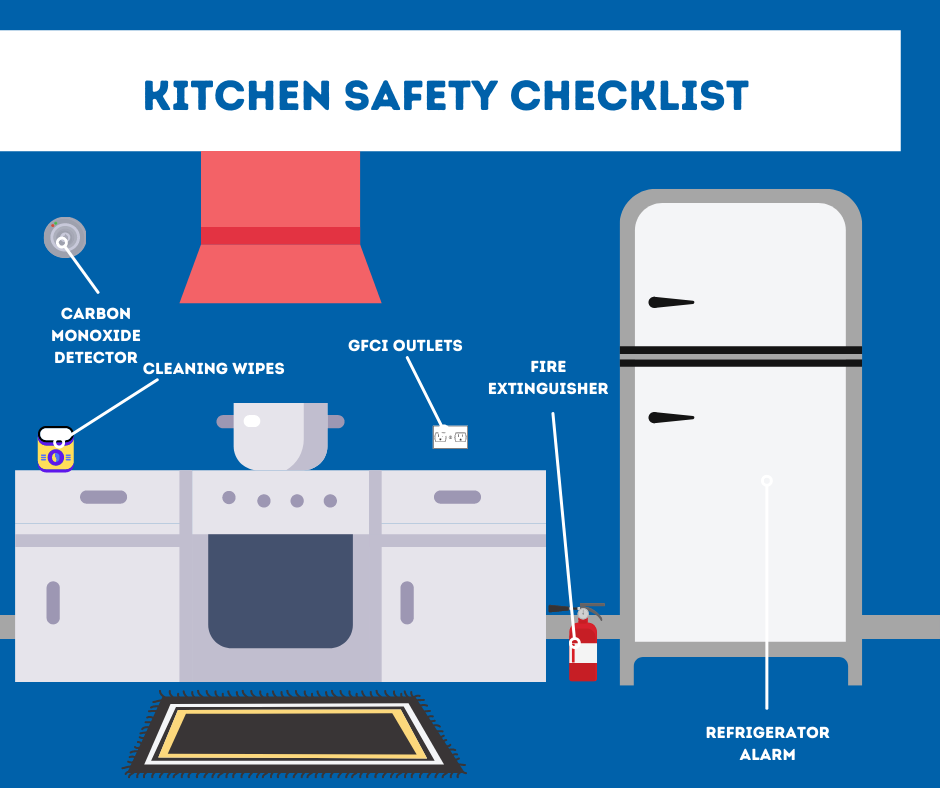
Kitchen Safety Checklist For Boston
The kitchen has room for items that should add safety to your house. Many of these things should be easy to add and should be found in the Target or Walmart:
-
Fire Extinguisher: A fire can come from from a neglected skillet or a towel that’s too close to a burner. Always have a fire extinguisher at the ready for any stove or oven emergencies.
-
GFCI Box On Every Outlet: A GFCI outlet should be used everywhere there’s nearby running water to prevent an electric shock. That includes the plug outlets around your sink and kitchen counter. For 30 years, it’s been code to have one GFCI per dedicated circuit. But if you don’t want every outlet to turn off when one outlet surges, you’ll want to use a separate GFCI for every outlet.
-
Monitored CO Detector: A CO detector is recommended for spaces that have a gas oven and stove. If your gas burners leak, the CO detector will play a loud noise and call your monitoring agent.
-
Disinfectant Wipes Or Spray: The most overlooked safety problem in the kitchen is actually bacteria and contamination that comes with raw meat and vegetables. Always keep disinfectant wipes or spray to sanitize your surfaces before and after preparing food.
-
Freezer and Refrigerator Alarm: The milk, meat, and perishables in the refrigerator need to stay at a constant temperature to be safe to eat. If you accidently leave the refrigerator door ajar, then an alarm beep will tell you to check the seal. Some refrigerators already have an alarm, others do not, and you’ll have to get an external alarm from the hardware store.
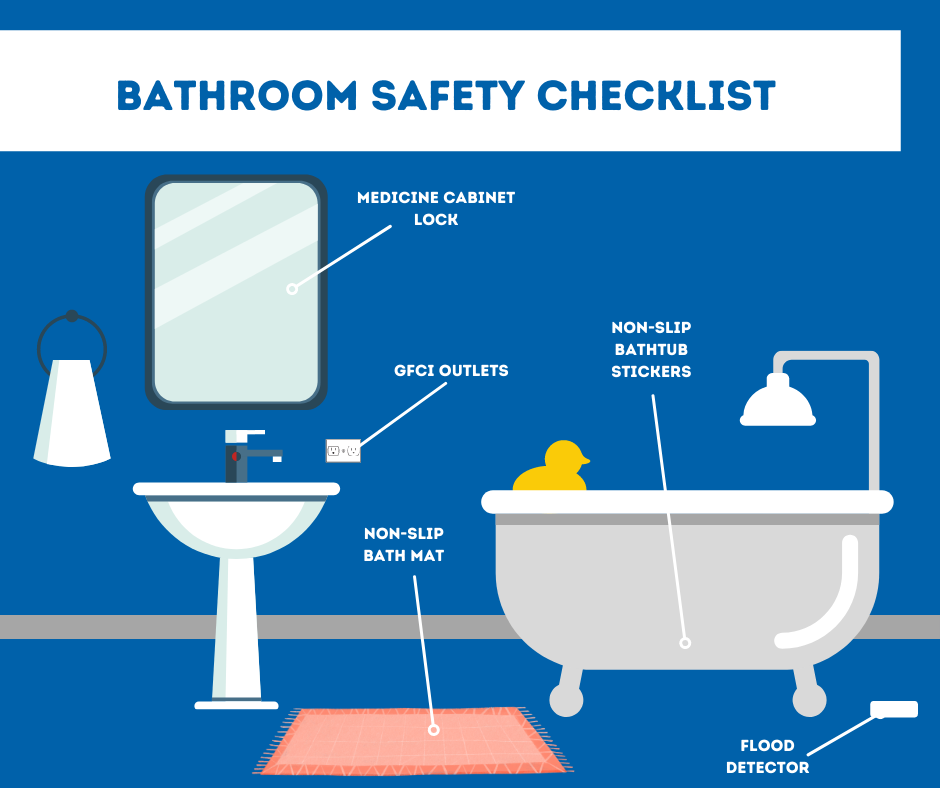
Bathroom Safety Checklist For Boston
Just because there’s not a lot of room in your bathroom there’s still safety issues. From flood prevention to medicine care, here are a few safety improvements for your bathroom:
-
Flood Detectors: A leaking toilet or tub can create an expensive amount of water damage. Discover leaks early with a flood detector and save yourself from renovating the entire bathroom.
-
No-slip Shower Mats: A slip in the bathroom can be painful, causing cuts, bruises, or broken bones. You can avoid these hazards with a non-slip bath mat for after your bath or shower.
-
No-slip Bathtub Strips: Another water hazard, a tub basin can be a slippery surface to be on. Make sure each has some non-slip stickies so your feet have a textured patch to gain traction.
-
Medicine Door Lock: If you have curious kids or someone with memory difficulties, you need to take additional care regarding prescription medicine. Secure your prescriptions by using a medicine cabinet with a child-proof lock.
-
GFCI Circuits: Similarly to the kitchen, you will have to also use a surge protecting GFCI outlet on each bathroom receptacle. These will shut off the electric current if water enters the outlet or there’s a harmful spike from a hair dryer or curling iron.
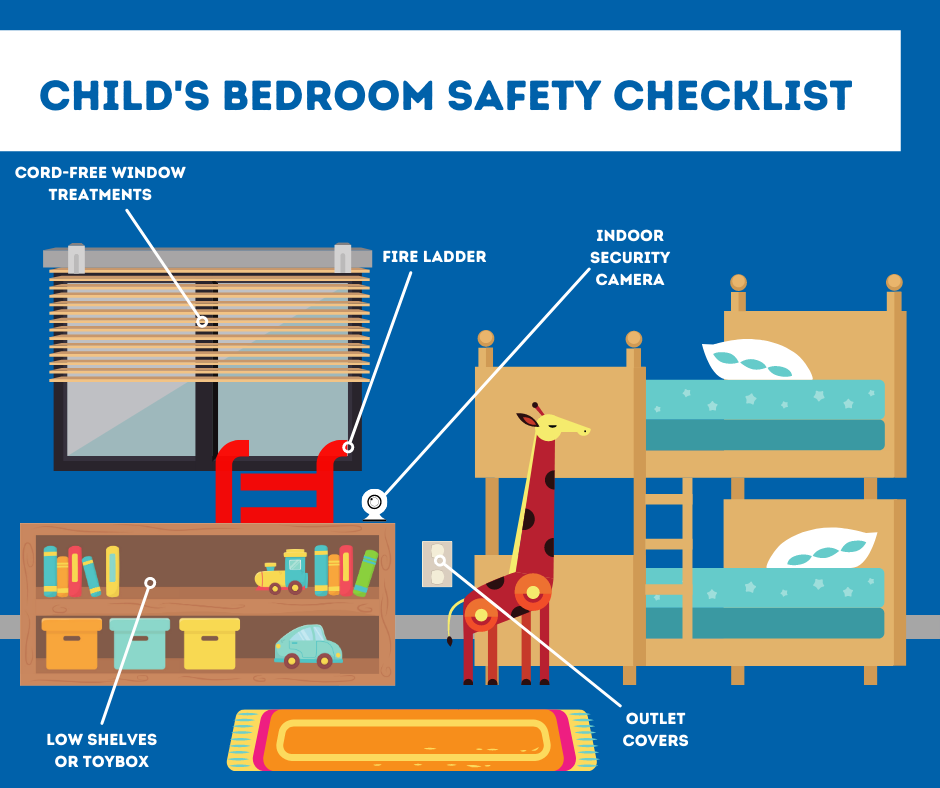
Kid’s Bedroom Safety Checklist For Boston
Your kid’s bedroom should pair safety with simplicity. If their window coverings or other items are safe but difficult to use, then your kids may get around the device with risky activities -- like climb a bookshelf -- to use them. Try these simple, yet safe, ideas:
-
Cordless Window Coverings: Safety agencies have designated window treatment cords an unsuspecting danger for kids and pets. Install motorized shades that kids can easily manage with a remote. Or go state-of-the-art and connect your motorized treatments to your ADT security system so they rise automatically at dawn, and lower at night for added darkness.
-
Indoor Security Camera: A camera perched on your child’s dresser can act just like a baby monitor that you can watch from your phone. And when they want your help, they can push the 2-way talk button included on the camera.
-
Outlet Covers: While every outlet should use outlet safety caps on them when you have little children, this is especially important in a child’s bedroom. It’s the main place in your house where your children will most likely hang out alone without parental supervision.
-
Window Fire Ladder: If you use bedrooms on above the first level, then you will want to put in a window escape ladder. These should let your children leave the house even if the stairs or lower levels are engulfed in smoke and fire. Just remember to go over how to employ them at least twice a year.
-
Toy Chest Or Low Shelves: It’s strange to view a toy chest as a safety component, but you’ll get it if you’ve ever stepped on a building block in your stocking feet. A uncluttered floor gives your child a quick way out during a safety or security event.
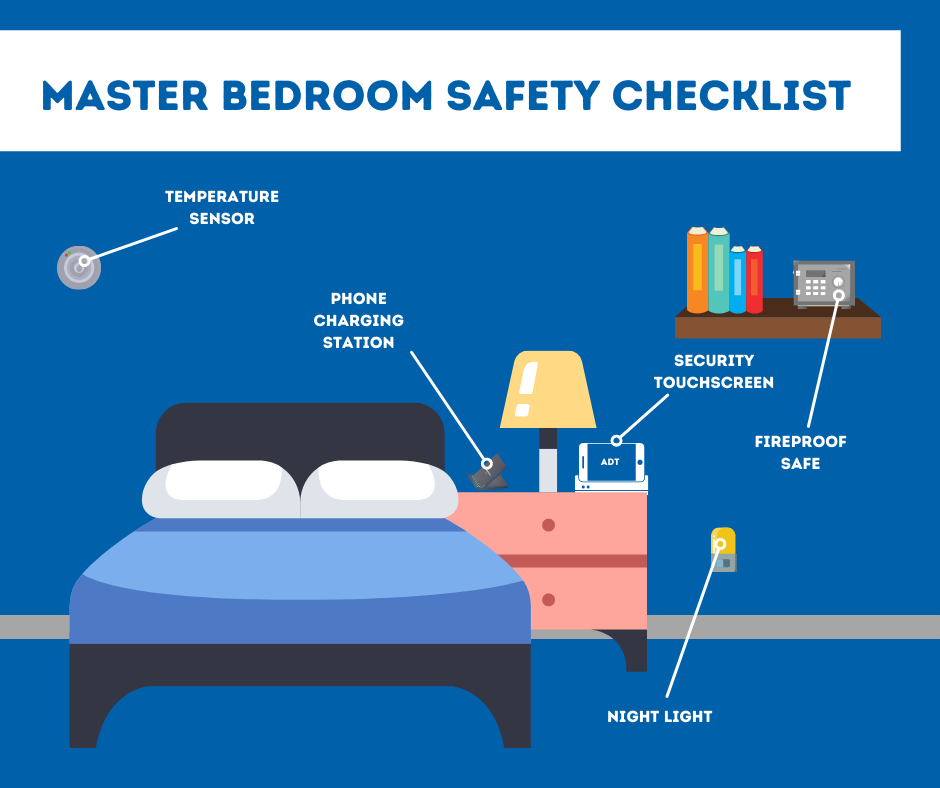
Master Bedroom Safety Checklist For Boston
Your bedroom should be your calm space, so let your safety components make you more responsive when there's an emergency event. After all, being wrenched awake by a high-decibel siren can be disorienting.
-
Smart Hub Touchscreen: Having a smart hub on your dresser gives you a sense of what’s going on without getting out of bed. You could always turn on your ADT smartphone app. However, the touchscreen is often better to use when you’re yawning and confused.
-
Phone Charging Station: We rely on our cell phones for almost everything now alarm clocks, news readers, time wasters, and --legend has it-- even phones. The only problem is that a depleted device will cut us off from communications if during an emergency. To keep it nice and ready, a an easy-to-use charging station is an important part of your nightstand.
-
Smart Lights Or Nightlights: A small light helps ground you when you’re bolted awake from a fire alarm or unexpected noises. If you have trouble falling asleep with a nightlight, install smart lights in your fixtures. Then you can control light anytime with a mobile device or voice direction.
-
Fireproof Lockbox: Stash your vital paperwork like social security cards, passports, or banking information in a fireproof safe. Your lockbox can be a bigger one that is located out of the way or a slender portable lockbox that you can snatch on your way out during an emergency event.
-
Heat Sensor: The issue with most bedrooms is that they might run too hot or be cold because they are located far away from the thermostat. A temperature sensor will communicate to your smart thermostat so you can have a comfortable, peaceful sleep at just the right temperature.
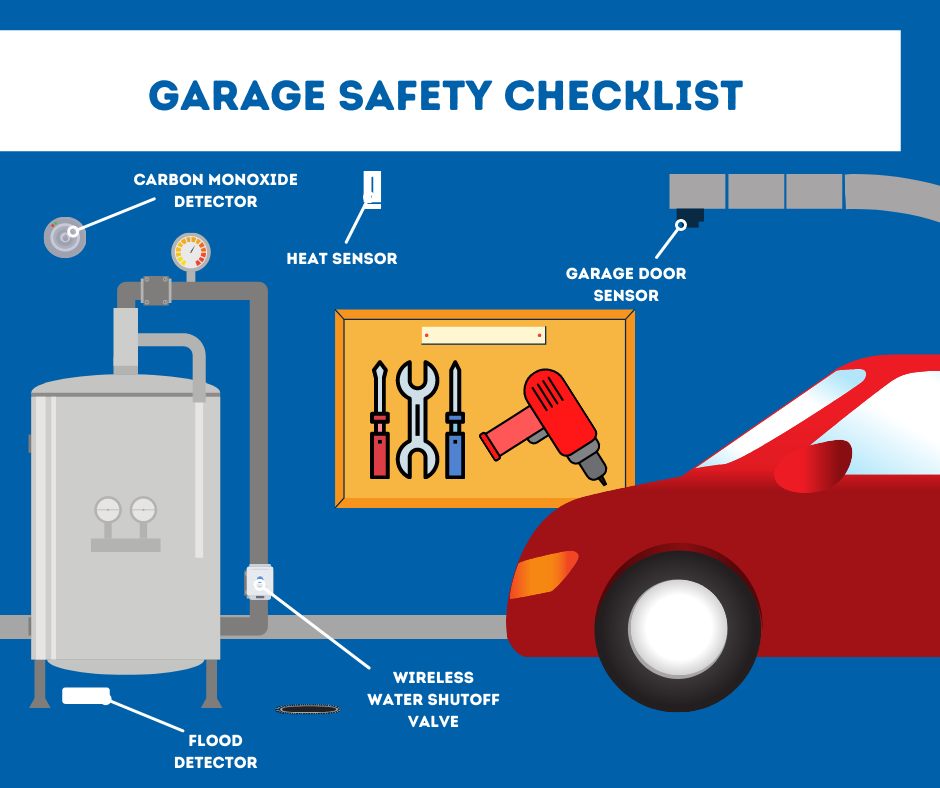
Garage/Basement Safety Checklist For Boston
Most safety needs in the garage or basement deal with your pipes or furnace. Seeing problems before they start can stave away larger emergencies in the future. So, as you walk around your storage areas, take note of these critical items:
-
Flood Detector Or Sump Pump Alarm: Putting a flood alarm in back of your water heater or sump pump can stop you from discovering a lake when you step into your basement or garage. Do you really want to waste your day drying the floor?
-
CO Alarm: It’s smart to install a carbon monoxide alarm in a place where a CO leak can happen. If you use a gas furnace, you should put a detector in the same area as your inbound pipes.
-
Wireless Water Shutoff Valve: If your flood alarm detects a hot water leak or a busted pipe, then you need to cut off the primary water valve at once. With a remote shutoff valve, you can stop water flow from your phone. That’s perfect when you’re out of town and get a flood sensor text on your phone.
-
Garage Door Sensor: Leaving the garage door up causes all types of headaches. You can lose heat or air through that open door, and critters or intruders can just walk in. A sensor will alert you to an open garage door and allow you to close it through the app.
-
Heat Sensor: A heat alarm in your garage or basement is a definite if you wonder about freezing pipes. The heat in these areas can be wildly different than the rest of the house, so you may need to maintain a closer eye on them with your mobile app.
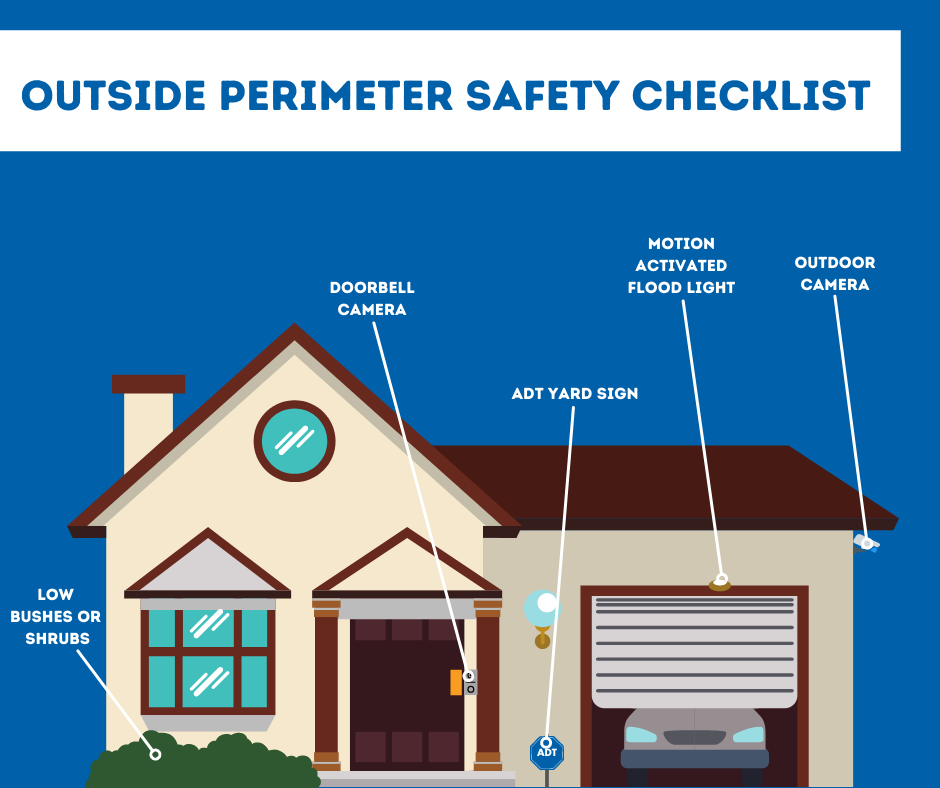
Outside Safety Checklist for Boston
Your front yard, drive, and front step are just as important to make safe as the inside of your house. Use this checklist to make your outside safe:
-
Doorbell Camera: See who’s arrived at the front door before you answer it and welcome visitors. See package deliveries and review video clips if they are stolen.
-
Outdoor Security Camera: You can install outdoor cameras to alert you to late night movement in your yard. These devices are nice in places where you might not have a window installed -- like around a cellar or by the garage door.
-
Low Shrubs: High foliage can offer some privacy, but they also block your line of sight of the yard and curb. Don’t provide potential thieves a dark shadow to hide. Plus, tall shrubs or foliage against your structure can jam up gutters and invite pests.
-
ADT Signage: One of the most popular disincentives for a break-in is advertising to would-be burglars that you own a monitored ADT security system. An ADT yard stick by the front door and a window sticker will show ne'er-do-wells that they ought to move on to an easier target.
-
Motion Controlled Flood Lighting: Light is the biggest enemy to those who sneak around in the shadows. Motion-controlled lights on your deck, patio, or garage can shoo lurkers away. Flood lights also help you see the walk when you get back home late after work.
Use Secure24 Alarm Systems To Help Complete Your Home Safety Checklist for Boston
While Secure24 Alarm Systems can’t help you with every item on your Boston home safety checklist, we can discuss a powerful home security. With alarms, security cameras, and home automation, we can personalize the ideal system for your family’s needs. Just call (617) 430-5865 to get started or complete the form below. Or personalize your own solution with our Security System Designer.
